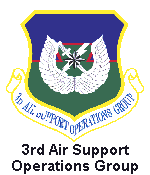
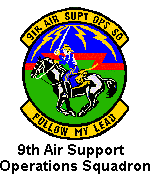
9th Air Support Operations Squadron
Heraldic Items
"Follow My Lead"


GUIDE TO AIR FORCE HERALDRY

 The original version of A Guide to Air Force Heraldry was written by William
M. Russell of the USAF Historical Research Center and published in 1985.
During the years that have elapsed since then, several Air Force regulations
and instructions have been issued to aid Air Force organizations with the
design, submission, and procurement of organizational emblems and flags. Most
recently, the governing policy on Air Force heraldry, AFI 84-105,
Organizational Lineage, Honors, and Emblems, has been revised with several
changes made in Chapter 3, "Air Force Heraldry." Consequently, the Air Force
Historical Research Agency (AFHRA) which receives many requests for assistance
and guidance in the creation of emblems, updated this guide to conform to the
policy changes and to give the field historian greater guidance. Success will
be measured by the user's ability to modify or create emblems meeting current
Air Force requirements and the needs of the organization.
The original version of A Guide to Air Force Heraldry was written by William
M. Russell of the USAF Historical Research Center and published in 1985.
During the years that have elapsed since then, several Air Force regulations
and instructions have been issued to aid Air Force organizations with the
design, submission, and procurement of organizational emblems and flags. Most
recently, the governing policy on Air Force heraldry, AFI 84-105,
Organizational Lineage, Honors, and Emblems, has been revised with several
changes made in Chapter 3, "Air Force Heraldry." Consequently, the Air Force
Historical Research Agency (AFHRA) which receives many requests for assistance
and guidance in the creation of emblems, updated this guide to conform to the
policy changes and to give the field historian greater guidance. Success will
be measured by the user's ability to modify or create emblems meeting current
Air Force requirements and the needs of the organization.
Chapter 1: Heraldry Through the Ages
 Heraldry as we know it today had its beginning in the early 12th century
during the period between the First and Second Crusades. To ensure recognition
while wearing armor and a helmet that partially hid the face, enterprising
knights began to use identifying symbols and devices called cognizances, which
were painted on their shields and embroidered on the pennons (cloth banners)
attached to their lances.
Heraldry as we know it today had its beginning in the early 12th century
during the period between the First and Second Crusades. To ensure recognition
while wearing armor and a helmet that partially hid the face, enterprising
knights began to use identifying symbols and devices called cognizances, which
were painted on their shields and embroidered on the pennons (cloth banners)
attached to their lances.
 For additional information regarding the History of Heraldry,
read the full chapter here.
For additional information regarding the History of Heraldry,
read the full chapter here.

Chapter 2: Organizational Emblems
 On 06 May 1918, Brigadier General Foulois established the policy for insignia
of aerial units, His declaration requiured that each squadron would have an
official insignia painted on the
middle of each side of the airplane fuselage. "The squadron will design their
own insignia during the period of organizational training. The design must be
submitted to the Chief of Air Service, AEF, for approval. The design should be
simple enough to be recognizable from a distance."
On 06 May 1918, Brigadier General Foulois established the policy for insignia
of aerial units, His declaration requiured that each squadron would have an
official insignia painted on the
middle of each side of the airplane fuselage. "The squadron will design their
own insignia during the period of organizational training. The design must be
submitted to the Chief of Air Service, AEF, for approval. The design should be
simple enough to be recognizable from a distance."
 For additional information regarding the design of Organizational Emblems,
read the full chapter here,
For additional information regarding the design of Organizational Emblems,
read the full chapter here,

Chapter 3: Designing an Air Force Emblem
 In designing an emblem for an organization, the most important factors to be
considered are the organization's history, its specified mission (such as
reconnaissance, airlift, fighter, medical services, security, civil
engineering, etc.), the proper symbols to be depicted in the emblem design,
the placement of the symbolic elements or "charges" on the design field, and
color selection.
In designing an emblem for an organization, the most important factors to be
considered are the organization's history, its specified mission (such as
reconnaissance, airlift, fighter, medical services, security, civil
engineering, etc.), the proper symbols to be depicted in the emblem design,
the placement of the symbolic elements or "charges" on the design field, and
color selection.
 For additional information regarding the design of Air Force Emblems,
read the full chapter here.
For additional information regarding the design of Air Force Emblems,
read the full chapter here.

Chapter 4: Processing Air Force Emblems
 AFI 84-105, Chapter 3, Paragraph 3.6. should serve as the authoritative guide
in the processing of Air Force emblems. The information in this chapter of the
"Guide to Air Force Heraldry" supplements the AFI.
AFI 84-105, Chapter 3, Paragraph 3.6. should serve as the authoritative guide
in the processing of Air Force emblems. The information in this chapter of the
"Guide to Air Force Heraldry" supplements the AFI.
 For additional information regarding processing of Air Force Emblems,
read the full chapter here.
For additional information regarding processing of Air Force Emblems,
read the full chapter here.

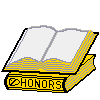

 9th Air Support Operations Squadron (ASOS)
9th Air Support Operations Squadron (ASOS)

Heraldic Items
|
|---|
|
|---|
|
Squadron Emblem
- Emblem
- Description: On a disc per fess enhanced dovetailed of one Azure
and Vert, a barrulet dovetailed of one Gules, overall a cavalry
soldier equipped Proper grasping in his dexter hand a sabre
bendwise sinister Gray emitting from the tip in chief four
lightning bolts arcing to base Or and mounted on a horse courant
Sable garnished of the fourth, all within a diminished border of the
sixth.
- Attached above the disc, a Yellow scroll edged with a narrow Black
border and inscribed "9TH AIR SUPT OPS SQ" in Black letters.
- Attached below the disc, a Yellow scroll edged with a narrow Black
border and inscribed "FOLLOW MY LEAD" in Black letters.
- Symbolism
- Ultramarine blue and Air Force yellow are the Air Force
colors. Blue alludes to the sky, the primary theater of
Air Force operations. Yellow refers to the sun and the
excellence required of Air Force personnel. The dovetailed
divider symbolizes the strong, interlocking relationship
between the Army and the Air Force. The mounted cavalry
soldier alludes to the joint cooperation and
interoperability between those two organizations. The four
arced lightning flashes signify speed, agility, swiftness
and the courage of Squadron members. They also denote the
integrated close air support through ground-to-air and
air-to-ground communications throughout the world.
|
1st Cavalry Division Shoulder Sleeve Insignia |
|---|
|

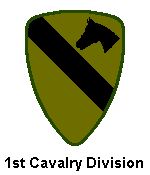
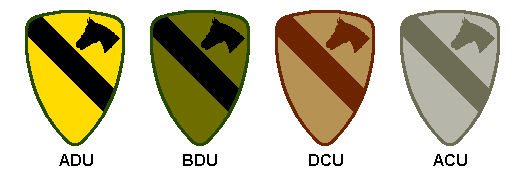 |
|---|
| 1st Cavalry Division Shoulder Sleeve Insignia Styles |
|---|
Shoulder Sleeve Insignia
- Description: On a yellow triangular Norman shield with rounded
corners 5 1/4 inches (13.34 cm) in height overall, a black diagonal
stripe extending over the shield from upper left to lower right and in
the upper right a black horse's head cut off diagonally at the neck
all within a 1/8 inch (.32 cm) green border.
- Symbolism: The color yellow, the traditional Cavalry color, and
the horse's head refer to the Division's original Cavalry
structure. Black, symbolic of iron, alludes to the transition to
tanks and armor. The black diagonal stripe represents a sword
baldric and is a mark of military honor; it also implies movement
"up the field" and thus symbolizes aggressive Úlan and attack. The
one diagonal bend, as well as the one horse's head, also alludes
to the Division's numerical designation.
- Background: The shoulder sleeve insignia was originally approved
for the 1st Cavalry Division on 03 January 1921, with several
variations in colors of the bend and horse's head to reflect the
subordinate elements of the division. The current design was
authorized for wear by all subordinate elements of the Division on
11 December 1934, and previous authorization for the variations
was cancelled. The insignia was redesignated for the 1st Air
Cavalry Division on 05 August 1968. It was redesignated for 1st
Cavalry Division (Airmobile) on 10 September 1968. The insignia
was redesignated for the 1st Cavalry Division on 24 May 1971.
 The United States Army Shoulder Sleeve Insignia (SSI) or shoulder
patch is a cloth heraldic device that uniquely identifies each major
US Army formation. The Shoulder Sleeve Insignia is worn on the left
upper arm, just below the shoulder seam of the uniform on all but the
Army Combat Uniform (ACU). On the Army Combat Uniform the Shoulder
Sleeve Insignia is attached to a Velcro backing and is then attached,
centered on a rectangle of Velcro on the arm.
The United States Army Shoulder Sleeve Insignia (SSI) or shoulder
patch is a cloth heraldic device that uniquely identifies each major
US Army formation. The Shoulder Sleeve Insignia is worn on the left
upper arm, just below the shoulder seam of the uniform on all but the
Army Combat Uniform (ACU). On the Army Combat Uniform the Shoulder
Sleeve Insignia is attached to a Velcro backing and is then attached,
centered on a rectangle of Velcro on the arm.
 Those soldiers who are combat veterans are authorized permanent wear
of their Shoulder Sleeve Insignia, earned during combat, on their
right shoulder. This shoulder sleeve insignia recognizes "former
wartime service" and is frequently called a "combat patch". The
Shoulder Sleeve Insignia currently issued in four basic color
combinations:
Those soldiers who are combat veterans are authorized permanent wear
of their Shoulder Sleeve Insignia, earned during combat, on their
right shoulder. This shoulder sleeve insignia recognizes "former
wartime service" and is frequently called a "combat patch". The
Shoulder Sleeve Insignia currently issued in four basic color
combinations:
- Full Color (SunSet Gold/Black) - Worn on the Army Dress Uniform
(ADU).
- Jungle Subdued (Green/Black) - Worn on the Battle Dress Uniform
(BDU).
- Desert Subdued (Tan/Brown) - Worn on the Desert Camouflage Uniform
(DCU).
- Subdued (Foliage Green/Gray) - Worn on the Army Combat Uniform
(ACU).
 The Shoulder Sleeve Insignia (SSI) of the 1st Cavalry Division has a
history as colorful as its design, reflecting the proud heritage of the
United States Cavalry in a timeless manner.
The Shoulder Sleeve Insignia (SSI) of the 1st Cavalry Division has a
history as colorful as its design, reflecting the proud heritage of the
United States Cavalry in a timeless manner.
 The insignia selected for the First Team patch was designed by Colonel
and Mrs. Ben Dorcy. The Colonel was then commander of the 7th Cavalry
Regiment at Fort Bliss, Texas. Mrs. Dorcy related that the combination
of the golden sunset at Fort Bliss and the traditional colors of the
Cavalry; blue and yellow, were a great influence on the background
color and the insignia. The choice of the horse's head for the insignia
was made by the family after they observed a mounted trooper ride by
their home on a beautiful blue-black thoroughbred. Later, to improve
visibility, the color scheme was modified replacing the blue for
black, the symbolic color of iron and armor.
The insignia selected for the First Team patch was designed by Colonel
and Mrs. Ben Dorcy. The Colonel was then commander of the 7th Cavalry
Regiment at Fort Bliss, Texas. Mrs. Dorcy related that the combination
of the golden sunset at Fort Bliss and the traditional colors of the
Cavalry; blue and yellow, were a great influence on the background
color and the insignia. The choice of the horse's head for the insignia
was made by the family after they observed a mounted trooper ride by
their home on a beautiful blue-black thoroughbred. Later, to improve
visibility, the color scheme was modified replacing the blue for
black, the symbolic color of iron and armor.
 On a "sunset" yellow triangular Norman Shield with rounded corners
5 1/4 inches in height, a black diagonal stripe extends over the
shield from upper left to the lower right. In the upper right, a black
horse's head cut off diagonally at the neck, appears within 1/8 inches
of an Army Green border. The traditional Cavalry color of yellow and
the horse's head is symbolic of the original organizational structure
of the Cavalry. The color black is symbolic of iron, alluding to the
organizational transition from mounted horses to tanks and heavy
armor. The black stripe, in heraldry termed a "Sable Bend", represents
a "baldric" (a standard Army issue belt worn over the right shoulder
to the opposite hip - sometimes referred to as a "Sam Browne belt")
which retains either a scabbard which sheaths the trooper's saber or
revolver holster.
On a "sunset" yellow triangular Norman Shield with rounded corners
5 1/4 inches in height, a black diagonal stripe extends over the
shield from upper left to the lower right. In the upper right, a black
horse's head cut off diagonally at the neck, appears within 1/8 inches
of an Army Green border. The traditional Cavalry color of yellow and
the horse's head is symbolic of the original organizational structure
of the Cavalry. The color black is symbolic of iron, alluding to the
organizational transition from mounted horses to tanks and heavy
armor. The black stripe, in heraldry termed a "Sable Bend", represents
a "baldric" (a standard Army issue belt worn over the right shoulder
to the opposite hip - sometimes referred to as a "Sam Browne belt")
which retains either a scabbard which sheaths the trooper's saber or
revolver holster. |
1st Cavalry Division Combat Shoulder Sleeve Insignia |
|---|
|


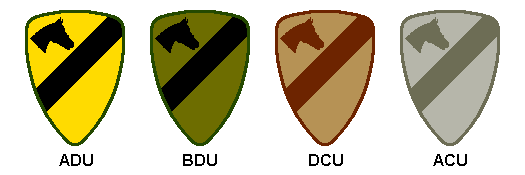 |
|---|
| 1st Cavalry Division Combat Shoulder Sleeve Insignia |
|---|
Combat Shoulder Sleeve Insignia
 During the Vietnam engagements, the "sunset yellow" field of the patch
was changed to a subdued Olive Drab (OD) green/black for the Battle
Dress Uniform (BDU) in order to minimize targeting of personnel. For
operations in desert environments, the field of the patch was again
changed to a tan (Khaki) color and the emblazoned, "Sable" black
charge elements was changed to saddle brown (Spice) so that the
contrast against the Desert Camouflage Uniform (DCU) was minimized.
More recently, in the deployment to Iraq and with the introduction of
new Army Combat Uniform (ACU), field of the patch was changed to
"Foliage/Green" and the charge elements were changed to Gray.
During the Vietnam engagements, the "sunset yellow" field of the patch
was changed to a subdued Olive Drab (OD) green/black for the Battle
Dress Uniform (BDU) in order to minimize targeting of personnel. For
operations in desert environments, the field of the patch was again
changed to a tan (Khaki) color and the emblazoned, "Sable" black
charge elements was changed to saddle brown (Spice) so that the
contrast against the Desert Camouflage Uniform (DCU) was minimized.
More recently, in the deployment to Iraq and with the introduction of
new Army Combat Uniform (ACU), field of the patch was changed to
"Foliage/Green" and the charge elements were changed to Gray.
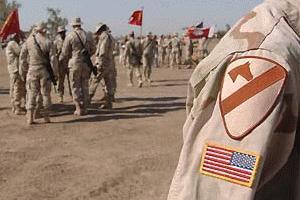 |
|---|
| 1st CD Shoulder Sleeve Combat Patch |
|---|
| |
|---|
 On 04 July 2004 when all of the elements and attached units of the
1st Cavalry Division deployed in Operation IRAQI FREEDOM II were
recognized for their first 90 days of combat service in a special
ceremony, the Division broke tradition, designed and issued a new
shoulder patch to be worn on the individuals right sleeve.
On 04 July 2004 when all of the elements and attached units of the
1st Cavalry Division deployed in Operation IRAQI FREEDOM II were
recognized for their first 90 days of combat service in a special
ceremony, the Division broke tradition, designed and issued a new
shoulder patch to be worn on the individuals right sleeve.
 The 1st Cavalry Division Combat Patch is a "mirror image" of the
Division patch in that the silhouette of the horse head and diagonal
line across the gold background was reversed so it points forward when
worn on the right arm of the uniform. It is the same concept as
utilized to display the US flag when worn on the right arm, in that
the field of stars of the flag is positioned in the upper right-hand
corner of the patch. It may look backwards, but the flag billowing
toward the back of a soldier indicates he is always advancing, never
retreating.
The 1st Cavalry Division Combat Patch is a "mirror image" of the
Division patch in that the silhouette of the horse head and diagonal
line across the gold background was reversed so it points forward when
worn on the right arm of the uniform. It is the same concept as
utilized to display the US flag when worn on the right arm, in that
the field of stars of the flag is positioned in the upper right-hand
corner of the patch. It may look backwards, but the flag billowing
toward the back of a soldier indicates he is always advancing, never
retreating. |
1st Cavalry Division Combat Distinctive Service Identification Badge |
|---|
|
 Recently, the official status of the "reversed patch" has come into
question and currently the combat patch has reverted to the original
patch design (not reversed). Meantime, those who were issued the
"reversed design", proudly wear them on their uniforms.
Recently, the official status of the "reversed patch" has come into
question and currently the combat patch has reverted to the original
patch design (not reversed). Meantime, those who were issued the
"reversed design", proudly wear them on their uniforms.
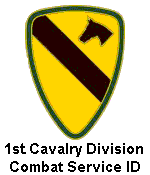 |
|---|
| "First-Team" |
|---|
 Description: The new insignia design currently authorized by the
Institute of Heraldry is a gold color metal and enamel device 2 inches
(5.08 cm) in height embodying a design similar to that of the shoulder
sleeve insignia.
Description: The new insignia design currently authorized by the
Institute of Heraldry is a gold color metal and enamel device 2 inches
(5.08 cm) in height embodying a design similar to that of the shoulder
sleeve insignia. |
1st Cavalry Division Shoulder Sleeve Insignia Design |
|---|
|
 Otherwise, other than the mirrored (reversed) image for combat
operations the patch has not changed in way from the original design
and shape. Occasionally, an unauthorized supplier of the 1st Cavalry
patch makes a design that does not conform with the geometry of the
patch design and measures are taken to remove it from the market. The
design, as authorized by the Institute of Heraldry, is shown below:
Otherwise, other than the mirrored (reversed) image for combat
operations the patch has not changed in way from the original design
and shape. Occasionally, an unauthorized supplier of the 1st Cavalry
patch makes a design that does not conform with the geometry of the
patch design and measures are taken to remove it from the market. The
design, as authorized by the Institute of Heraldry, is shown below:
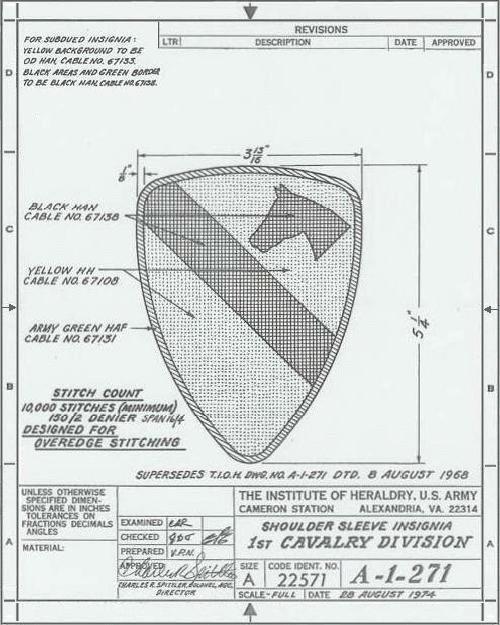 |
|---|
| 1st Cavalry Division Shoulder Sleeve Insignia Design |
|---|
|


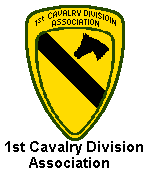















 eMail Your WebSite Comments.
eMail Your WebSite Comments.


 Return to 1st Cavalry Division Organization.
Return to 1st Cavalry Division Organization.

Copyright © 1996, Cavalry Outpost Publications ® and
Trooper Wm. H. Boudreau, "F" Troop, 8th Cavalry Regiment (1946 - 1947). All
rights to this body of work are reserved and are not in the public domain, or
as noted in the bibliography. Reproduction, or transfer by electronic means,
of the History of the 1st Cavalry Division, the subordinate units or any
internal element, is not permitted without prior authorization. Readers are
encouraged to link to any of the pages of this Web site, provided that proper
acknowledgment attributing to the source of the data is made. The information
or content of the material contained herein is subject to change without
notice.
Revised 10 Sep '11 SpellChecked



![]()



![]()
![]() Heraldry as we know it today had its beginning in the early 12th century
during the period between the First and Second Crusades. To ensure recognition
while wearing armor and a helmet that partially hid the face, enterprising
knights began to use identifying symbols and devices called cognizances, which
were painted on their shields and embroidered on the pennons (cloth banners)
attached to their lances.
Heraldry as we know it today had its beginning in the early 12th century
during the period between the First and Second Crusades. To ensure recognition
while wearing armor and a helmet that partially hid the face, enterprising
knights began to use identifying symbols and devices called cognizances, which
were painted on their shields and embroidered on the pennons (cloth banners)
attached to their lances.![]() For additional information regarding the History of Heraldry,
read the full chapter here.
For additional information regarding the History of Heraldry,
read the full chapter here.
![]()
![]() On 06 May 1918, Brigadier General Foulois established the policy for insignia
of aerial units, His declaration requiured that each squadron would have an
official insignia painted on the
middle of each side of the airplane fuselage. "The squadron will design their
own insignia during the period of organizational training. The design must be
submitted to the Chief of Air Service, AEF, for approval. The design should be
simple enough to be recognizable from a distance."
On 06 May 1918, Brigadier General Foulois established the policy for insignia
of aerial units, His declaration requiured that each squadron would have an
official insignia painted on the
middle of each side of the airplane fuselage. "The squadron will design their
own insignia during the period of organizational training. The design must be
submitted to the Chief of Air Service, AEF, for approval. The design should be
simple enough to be recognizable from a distance."![]() For additional information regarding the design of Organizational Emblems,
read the full chapter here,
For additional information regarding the design of Organizational Emblems,
read the full chapter here,
![]()
![]() In designing an emblem for an organization, the most important factors to be
considered are the organization's history, its specified mission (such as
reconnaissance, airlift, fighter, medical services, security, civil
engineering, etc.), the proper symbols to be depicted in the emblem design,
the placement of the symbolic elements or "charges" on the design field, and
color selection.
In designing an emblem for an organization, the most important factors to be
considered are the organization's history, its specified mission (such as
reconnaissance, airlift, fighter, medical services, security, civil
engineering, etc.), the proper symbols to be depicted in the emblem design,
the placement of the symbolic elements or "charges" on the design field, and
color selection.![]() For additional information regarding the design of Air Force Emblems,
read the full chapter here.
For additional information regarding the design of Air Force Emblems,
read the full chapter here.
![]()
![]() AFI 84-105, Chapter 3, Paragraph 3.6. should serve as the authoritative guide
in the processing of Air Force emblems. The information in this chapter of the
"Guide to Air Force Heraldry" supplements the AFI.
AFI 84-105, Chapter 3, Paragraph 3.6. should serve as the authoritative guide
in the processing of Air Force emblems. The information in this chapter of the
"Guide to Air Force Heraldry" supplements the AFI.![]() For additional information regarding processing of Air Force Emblems,
read the full chapter here.
For additional information regarding processing of Air Force Emblems,
read the full chapter here.
![]()













![]() eMail Your WebSite Comments.
eMail Your WebSite Comments.
![]()
![]()
![]() Return to 1st Cavalry Division Organization.
Return to 1st Cavalry Division Organization.
![]()